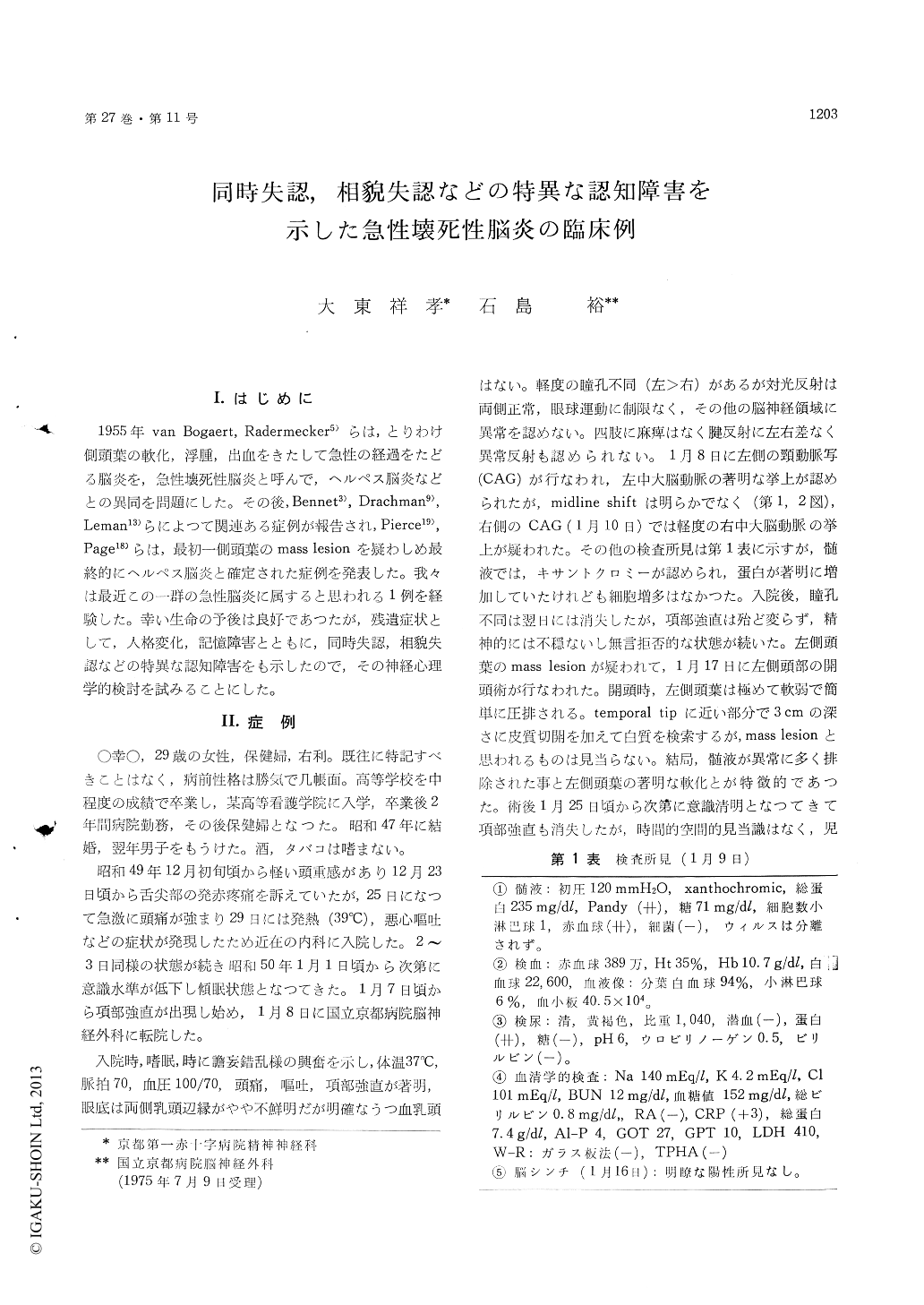Japanese
English
- 有料閲覧
- Abstract 文献概要
- 1ページ目 Look Inside
I.はじめに
1955年van Bogaert,Radermecker5)らは,とりわけ側頭葉の軟化,浮腫,出血をきたして急性の経過をたどる脳炎を,急性壊死性脳炎と呼んで,ヘルペス脳炎などとの異同を問題にした。その後,Bennet3),Drachman9),Leman13)らによつて関連ある症例が報告され,Pierce19),Page18)らは,最初一側頭葉のmass lesionを疑わしめ最終的にヘルペス脳炎と確定された症例を発表した。我々は最近この一群の急性脳炎に属すると思われる1例を経験した。幸い生命の予後は良好であつたが,残遺症状として,人格変化,記憶障害とともに,同時失認,相貌失認などの特異な認知障害をも示したので,その神経心理学的検討を試みることにした。
The authors have studied a 29-year-old right-handed female patient, who developped a paticulartype of visual agnosia as the sequellae of AcuteNecrotizing Encephalitis. After acute or sabacutestage during about for weeks, various neuropsy-chiatric and neuropsychological symtoms had ap-peared. These were as follows;
1) Personal change; she became very childlikeand imprudent.
2) Memory Disorders; she presented retrogradeamnesia for seven or eight years and incomplete"oubli a mesure". The short term memory wasmost massively impaired as compared with immediateor remote memory. The orientation for time andspace was almost preserved and did not appearedthe tendency to make confabulation.
3) Very mild amnestic aphasia or semantic aphasiawas revealed on the precise examinations.
4) Visual agnosia was the most caracteresticsymptom of this patient, the constituents of which were:
a) partial agnosia for figurative pictures and si-multanagnosia ; the more the complexity of pictures,the more the difficulty of recognizing them.
b) agnosia for faces or prosopagnosia ; she couldnot recognize the faces of familiar persons such asthe parents of her husband, her friends, her doctorsor nurses.
c) agnosia for animals; she failed to recognizeor identify many animals and birds.
d) mild topographical disorientation and severetopographical memory loss.
From the results of our neuropsychological ex-periments on this patient, it is concluded that herability to achieve recognition of unfamilar faceswas not so impaired, but retention of them wasdrastically disorders and that it was same with thevisual retention of many animals and birds. How-ever, with the Benton's Visual Retention Test (ac-cording to the Multiple Choice Method), she broughtabout relatively good results. Then, for the purposeof explaining the prosopagnosia in this case, wehave insisted on the factors of visual memory im-pairment, not only of faces but also of many otherindividual objects, and it is also noted that thesimultanagnosia in this case may be attributed tothe disability of grasping the meanings of moreindividual pictures.
Based on the neurological and neuropsychologicalfindings, it is possible to say that the lesions of ourpatient are estimated to extend to the both sides ofthe cerebral bases, perhaps principally to the baseof the left cerebral hemisphere.

Copyright © 1975, Igaku-Shoin Ltd. All rights reserved.


